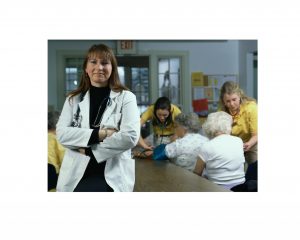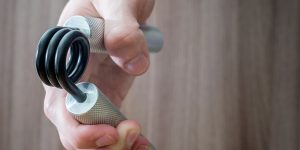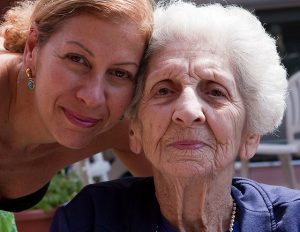Dr. Mauk’s Boomer Blog
Each week, Dr. Kristen Mauk shares thoughts relevant to Baby Boomers that are aimed to educate and amuse.
Dr. Kristen L. Mauk, PhD, DNP, RN, CRRN, GCNS-BC, GNP-BC, FAAN

Guest Blog: Healthcare tools and technology that help seniors continue to live at home
Advanced technologies in the healthcare niche such as GPS, motion-sensors and social networks that are senior focused might help seniors keep living comfortable in their homes. Medicaid and Medicare – two of the most powerful government agencies in the US – are aiming to develop cost efficient alternatives for nursing homes and assisted living facilities. Many tech-savvy families wish for their loved ones to live nearby and thus be able to balance their personal lifestyles with caregiving. Fortunately, technology is here to help.
General costs for assisted living and nursing home care keep increasing. The rates are incredibly high, whereas the general cost of at-home senior care has boosted with less than 1% in the last 5 years. At a national scale, the median cost for nursing homes increased to roughly $85,000 in 2013 as opposed to $63,000 in 2012. Furthermore, nearly 90% of citizens in the US wish to live alone in their homes rather than be placed in an assisted living facility.
Advanced technology makes caregiving a lot easier
Even though IoT (the internet of things), mobile devices, analytics, big data and cloud-based services allow nearly every age category to make use of technology for improved health, it is it is quite obvious that seniors can also reap benefits. That’s certainly good news since people with ages above 65 (41 million in the US), will represent one fifth of US’s population by 2050. By then, the US will have 19 million people above 85. If the country chooses to start using advanced technology now, things will look pretty good in 35 years when the lifestyle of the average senior will be pretty comfortable and laid-back.
Seniors are concerned about their financial, emotional and physical safety
A lot of seniors today fear for their financial, physical and emotional safety. They’re often aware that if their loved ones live nearby, they’ll somehow be compelled to look after them. Fortunately, technology comes to the rescue and eases the job of an adult to take care of his/her aging parent. Family members will be relieved of the burden because savvy gadgets and remote devices allow them to keep a close eye on their loved ones without having to check on them every single day. Experts agree that if more seniors would be open to using advanced technology, they could enjoy a much comfortable lifestyle by themselves.
However, let’s not forget that today’s seniors didn’t grow up tech-savvy. This means that they might feel uncomfortable using technology; because of this developers must consider crafting gadgets that are efficient but also easy to use. Twenty years from now seniors will probably use gadgets just as well as youngsters; but before that happens, the following should be checked out.
- Sensors – advanced patient monitoring. These devices can easily be installed around the house. They send signals alerting caregivers of prospective falls, injuries or skipped meals
- GPS tracking technology – excellent for keeping track of a loved one’s whereabouts.
- Apps – there’s a range of apps you can use to keep an eye on an aging parent. Both communication and monitoring apps are tools caregivers can use to watch over their loved ones. Among some of the most well-known we should mention Philips Lifeline, TrackerAssist, Red Panic Button and 5Star Service.
- Remote monitoring tools – these are targeted at seniors needing regular monitoring. There are lot of devices nowadays that monitor blood glucose, heart rate and blood pressure.
- Telehealth – the ability of modern telehealth systems is to use standard video-conferencing and phone systems to connect senior patients with nurse practitioners, physicians and mental health specialists. Furthermore, recent research highlights some pretty advanced technologies; these are meant to change the way seniors get regular checkups.
Seniors have realistic chances of living comfortably in their homes in spite of their health issues. Advanced technology can help them. The tools currently available are quite useful and innovative; however, caregivers must teach them how to use them. Very few seniors find residential care homes and assisted living facilities a viable lifestyle alternative. They don’t want to leave the comfort of their homes, but they’re quite aware that they can’t do everything alone either.
Guest Blog: Four Portable Exercise Tools to Take on Your Next Trip
Are you always on the go?
Whether you’re visiting grandchildren or traveling for work, it can be difficult to fit workouts in while traveling, especially if you’re staying in hotels that have limited or no exercise equipment available.
That being said, there’s no excuse not to exercise while traveling.
These four portable exercise tools are lightweight and easy to pack. Take them with you and squeeze in a workout no matter where you’re staying.
1. Resistance Bands
Resistance bands are great for fitting in strength training workouts. Use them in your hotel room or take them outside.
The best way to use resistance bands is to set up a full-body circuit to keep your heart rate elevated as you work a variety of muscle groups. Focus on compound movements like squats, rows, and overhead presses to get the most bang for your buck.
2. Yoga Mat
Sitting on a plane or in a car really takes a toll on your muscles and joints.
To counteract the stiffness that often comes with traveling, bring a yoga mat with you and do some stretches every day.
Want to stretch but don’t know where to start? Try focusing on your legs or lower back first. They typically take a beating during long trips.
If you’re really lost, you can always find yoga or stretching tutorials online, too.
3. Ab Wheel
An ab wheel obviously works your core, but it also can tone your arms, chest, and shoulders at the same time.
Ab wheels take up very little space in a suitcase, and they’re easy to use even in the smallest of hotel rooms. Give one a try during your next trip!
4. Hand Exercise Tool
If you want a truly balanced physique, don’t neglect your hands and forearms! Training these small muscles also improves your overall strength, and they can also help relieve pain stiffness caused by arthritis or carpal tunnel syndrome.
Tools like exercise putty and grip trainers are small and lightweight, and they can help you sneak in your workouts anytime, anywhere. You can even use them while you’re on a plane or in a taxi!
Frequent travel isn’t an excuse to slack on your workouts. Just get creative. Pick up one (or more) of these exercise tools today to easily fit in a sweat session no matter where you are.
5 tips for making an elderly relative’s home more accessible
 Within the next ten years, the number of people and families with elderly relatives to care for is likely to exponentially increase, with the old in some Western populations actually likely to outnumber the young by the early 2020s. This means that more and more families will have to make long-term plans to care for a relative into old age. The added pressure of a rising elderly population will manifest itself in more money needed for public and social care provision.
Within the next ten years, the number of people and families with elderly relatives to care for is likely to exponentially increase, with the old in some Western populations actually likely to outnumber the young by the early 2020s. This means that more and more families will have to make long-term plans to care for a relative into old age. The added pressure of a rising elderly population will manifest itself in more money needed for public and social care provision.
In order to both save money and (more importantly) provide a more comfortable and enjoyable experience for our elderly loved ones who are in need of social care, it’s going to be necessary to make more provisions for our older friends and relatives to be cared for in their home.
There are a number of different types of accessibility alterations which may be required if your elderly loved one suddenly has difficulty getting around the house. These include:
• Help accessing a home (e.g. ramps or hand rails when approaching the front door).
• Help getting around a home (e.g. ramps, stair lifts, more grab rails and handles for getting up and down stairs/ in and out of rooms.)
• Help with mobility in the kitchen and bathroom.
• Help with visibility/poor vision in the home
• Alarm/warning systems in the event of an accident or fall.
These are the main types of obstacles which an elderly relative may face as they deal with the difficult challenges and lifestyle alterations caused by decreased mobility in old age. Below are 5 of the most useful tips which could make all the difference, and hopefully ensure that your elderly friend or family member lives a much happier and fulfilled life.
1. Move the essentials downstairs
Moving all the essential facilities in your house to the ground floor can be the simplest way to improve overall access and ease any potential mobility issues which an elderly loved one may face. If there’s a way of suitably renovating the house so that there’s access to a bedroom, dining area and living quarters on the ground floor, then this will minimize the risk of any trips, falls, emergencies or accidents.
The decision to move all the major facilities/core rooms in a home to one floor may form part of a wider conversation about whether an elderly relative may wish to downsize to a bungalow, or a house with easier accessibility built in to the design.
2. Make bathrooms easier to use
Bathing and washing are the most private and essential of daily rituals, and a person’s ability to bathe and wash safely and easily is arguably central to their sense of dignity and self-esteem. This means that accessibility improvements to a bathroom are arguably some of the most urgent alterations you can/should be making to a home.
Helpful structural changes to a bathroom include:
• Level access/walk in showers, ensuring that an elderly person doesn’t have any immediate trip hazards, and minimising the risk of falls as they get in or out of the bath/shower.
• Handrails mounted to the walls, should an elderly relative require help getting up off the toilet.
• Removing any other extraneous trip hazards, such as bath mats or even ripping up tiled surfaces which may inadvertently mean a person could slip or trip when the surface becomes wet.
3. Stair/wheel chair lifts
These can be an essential addition to any household and are once again an invaluable tool for minimising trips and falls. If your elderly friend or loved one is adamant that they don’t want to make too many major changes to their day-to-day lifestyle and want to keep their room layout broadly the same, then a chair lift can be a great way to maintain both continuity and guarantee safety. Installation and maintenance are increasingly simple.
4. Replacing household accessories
By this, we mean replace everyday household accessories which control the day-to-day operation of the house. These include light switches and door handles. Switching your existing light switches to touch lights or dimmer switches can give an elderly relative an opportunity to take advantage of more subtle lighting states, which is especially useful if they are partially sighted/having difficulty seeing in darker rooms. Likewise, replacing any door knobs with lever handles is an easy way to ensure that your elderly relative can enjoy easier mobility when moving between rooms.
Likewise, re-arranging kitchen drawers and storage to make it more easily accessible is another straightforward way of improving accessibility and minimizing risk.
5. Installing a personal alarm system
This may be a source of understandable reluctance for someone who may be having to confront problems with mobility. After all, conceding that you need some of kind of emergency back-up system can, in turn, feel like an admission of vulnerability, and preparing for a worst-case scenario that none of us want to think about as we get older.
Nevertheless, installing a personal alarm system in the event of any serious accident or fall is a vital last line of defense in ensuring that your elderly relative or loved one is safe and secure in their own home.
A number of telecare systems allow a homeowner to alert a carer or member of the emergency services should they find themselves falling victim to a trip, fall or major accident.
Encore Care Homes offer care homes across the south of England. Their private homes offer palliative care, short-term respite care, long-term residential, and nursing care.
4 Home Improvements Caregivers Should Make
Paige A. Mitchell
If you’re caring for a family member at home, you’ll want to ensure your house is a safe, healthy environment for everyone involved. You’ll likely have some adjustments to make in order to make your home more comfortable for an ill or impaired loved one. Consider the four home improvements below.
1. Declutter and re-decorate
Keep floors clear of toys and shoes. Strategically rearrange the furniture, so that your loved one is able to remain stimulated and engaged while they sit. For example, they may enjoy some natural sunlight and the view of nature from a comfortable chair near a window. Personal touches and familiar objects can make Alzheimer’s patients more comfortable.
2. Enhanced access
It’s important to review each room in the house to determine how accessible it is to someone who is ill or impaired. The American Association of Retired Persons’ checklist includes zero-threshold and wide entrances for wheelchairs and walkers, low light switches and door knobs that are reachable to someone in a wheelchair, and non-slip flooring and grab bars in at least one bathroom.
3. Maintain your home
Whether you’re caring for someone who is ill or not, it’s important to conduct regular home maintenance to ensure it’s a truly healthy environment. For example, replacing batteries in smoke detectors is especially important if your loved one is forgetful and susceptible to forgetting that something is on the stove. Take full advantage of your home repair insurance to save time, energy, and money on repairs.
4. Ask for help
Fifty percent of caregivers report feeling depressed. If you’re suffering from fatigue, isolation, irritable, and/or ill, it’s important to take a step back to take care of yourself. Don’t forget to ask for help when you need it. Seek an expert opinion for objective advice on whether you should consider placing your loved one in assisted care.
Guest Blog: 10 Signs Your Aging Loved One Needs Support at Home
It can be difficult to see your parent or relative age. At one time, he could do anything. Now, it seems as though age has gotten the best of him. If you’ve seen changes in your loved one due to age, he may need extra help at home. The following are some of the most common signs of someone who is in need of a nurse or senior caregiver.
#1: Unkempt Home
If there has been a drastic change in the way that your loved one keeps his home that may be a sign he lacks the energy or physical ability to pick up and clean. Extra support at home can ensure that your loved one lives in a healthy, safe environment.
#2: Missed Medications
Forgetfulness is common in older individuals. Missing medications can lead to withdrawal and the return of symptoms of medical problems. It can lead to more serious problems as well – stroke, heart attack, etc. Help at home can remind your loved one to take medications as prescribed.
#3: Missed or Canceled Medical Appointments
Forgetfulness and the inability to drive to appointments can lead to failing health. A senior care worker can provide transportation and encouragement to attend all medical appointments.
#4: Body Odor
Just as cleaning and picking up the home can be physically demanding, taking a shower or bath is too. With someone in the home, your loved one can get the assistance needed to get into the shower and out of it to keep him clean and feeling refreshed.
#5: Sudden Change in Weight
Medical problems can cause lost pounds, but not being able to cook healthy meals can be the reason as well. Since it can be difficult to cook when feeling tired or lacking energy, someone in the home can make sure that he has meals ready or set up a meal program that gets food delivered on a schedule.
#6: Problems with Mobility
Balance and walking can be hard as people age, and this can lead to falls causing serious injuries. Help with completing daily tasks can reduce the risk of falls.
#7: Confusion or Uncertainty
This can cause a lot of distress for your loved one. Have someone there to lend an ear or explain something that doesn’t make much sense can calm the anxiety of your loved one to improve his quality of life.
#8: Depression
Losing interests in hobbies or activities he used to enjoy could be a sign of depression that can lead to many other problems. Having a caregiver provide support and encouragement can help your loved one feel better or get the mental health he needs.
#9: Mail Piling Up or Unpaid Bills
It can be easy to forget to pay a bill from time to time, but if it becomes a habit, it might be a good idea to have someone help with going through mail and managing bills. This is one of the services that senior care workers provide in addition to helping with other daily tasks.
#10: Diagnosis of an Age-Related Medical Problem
Alzheimer’s or dementia can cause a loved one to forget or engage in risky behaviors. Having someone by your loved one’s side most of the day can help minimize the risk of him hurting himself.
Your parent or relative may have taken care of you for many years. Now, it’s your turn to care for him. Home care can help you do that. Look into the many options available if your loved one exhibits any of these symptoms.
About the Author:
Kendall Van Blarcom is a licensed marriage and family therapist providing personal consulting to seniors who need someone to talk with to improve the quality of their lives. More information can be found about personal consulting at http://www.kvanb.com.
Guest Post: “Hitting a wall” – Why it is the biggest risk of marathon caring.
Running a marathon is one of the toughest things that you can do. Doing the full 26.2 miles requires grit, determination and a bit of luck. Luck in the sense that it reaches a point along the marathon whereby your will to run is gone and all you can do is hope that your body doesn’t give in. You require a lot of energy to run a marathon but the fact that it is a competitive event makes it difficult for stop and snack up. You, therefore, have to do with the food reserves stored in your body. The problem with this, however, is that the body can only store a limited amount of food reserves. This reserve is depleted way before you complete the marathon and it is at this point that the “wall” appears.
The wall.
To provide you with the energy to run, food is broken down to supply you with this energy. The primary food item that broken down to generate energy is carbohydrates since it requires very little oxygen to do so. When you are running, you let in very little oxygen into the blood stream and that is why carbohydrates are broken down first. The body can hold about 2000 calories of carbohydrates at any given time and this reserve can only last up to the 20th mile. From this point, the body turns to the fat deposits in the body for energy generation. Breaking down fats to produce energy generates a lot of waste products and this contaminates your interior. It also requires a lot of oxygen but since you are not taking in enough air, the body resorts to burning your muscles to generate the needed oxygen. This has the effect of making you feel like you are pulling a heavy load with your feet. Since your body is concentrating on generating energy, your focus shifts from running to this activity. You, therefore, find it difficult to concentrate on running and those who are not of strong will find it easy to give up.
Marathon caring and ‘The Wall”.
Aging brings with it a lot of challenges and at some stage in life, we would be expected to take care of our loved ones. It could be our parents, grandparents or other family members. Most would think that it will only be for a short period of time but the truth is that it usually stretches several years and this is what makes it a marathon. Taking care of another person is very challenging and it will overwhelm even those claiming to be strong willed. It requires that you feed, clothe as well as clean up the person under your care. You are in charge of their medication as well and this means that you have to monitor their pills to make sure they never run out. See how overwhelming that can be?
When compared to a marathon, all these responsibilities represent the various stages of a marathon. It is easier at the beginning since you are all psyched up and full of energy. It gets difficult with time as your ‘energy reserves’ are depleted and your enthusiasm fades. At this point, it is only a matter of time before you ‘hit the wall’.
The wall of a marathon caregiver.
The wall to a marathon caregiver represents that point when you see your dependent as a burden. This is that point when you are no longer excited to see those in your care. The wall is a very difficult point since it could see you neglect those in your care.
Keeping the wall at bay.
There are a few things that you can do to keep the way at bay. The first thing is to understand the course and this entails understanding your dependents better. If they have any illnesses, get to understand them as this will make it easy for you to manage them. Learn how to take care of old people and you can do that by checking out care homes near me. This will make you a better care giver and better equipment to avoid the wall.






